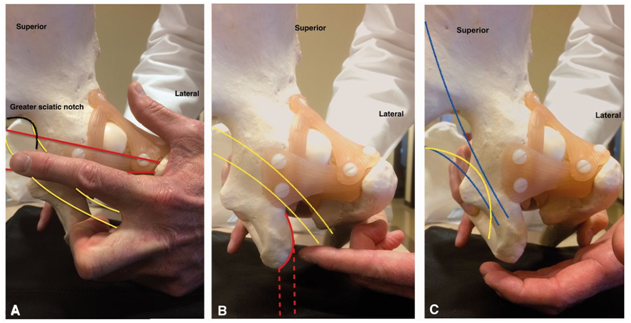The presence of deep pain in the buttock or posterior hip which is caused from non-discogenic and extrapelvic entrapment of the sciatic nerve is called Deep Gluteal Syndrome. Prior in medicine deep pain in the buttock was referred to as Piriformis Syndrome. This is because the main muscle palpated which was painful in the deep buttock or posterior hip is the piriformis muscle. However, many more structures are in the deep buttock area that can be a cause of or contributing factor to deep pain in the buttock. The sciatic nerve runs through the sciatic notch underneath the piriformis in most people although there are anatomical variations. The nerve has a great amount of mobility with hip movement because of the anatomical location yet because of anatomical variations this motion may be affected.
In deep hip flexion, abduction, and external rotation the sciatic nerve glides across the posterior hip region called the greater trochanter, a boney prominence. Several anatomical structures can be a cause of entrapment of the sciatic nerve which can cause deep buttock pain as well as pain that runs down the back of the leg. Several other structures can be the source of deep buttock pain which makes it very important that the provider a patient sees is able to perform a very thorough history and physical exam to rule out which structure or structures are the cause of the pain. These structures include the sciatic nerve, piriformis muscles, gluteal muscles, the hamstrings muscles, fibrous band containing blood-vessels, gemelli muscles, obturator internus muscle, vascular structures, and space occupying lesions such as a tumor. Tightness of another deep hip muscle called the quadratus femoris can influence the function of the posterior hip greatly and needs to be assessed. Other possible differential diagnosis can be lumbar spine facet joint irritation, sacroiliac joint dysfunction, cluneal nerve irritation, obturator hernia, pudendal nerve entrapment, myofascial trigger points in the gluteals, quadratus lumborum, ischiofemoral impingment, greater trochanter bursitis or greater trochanter ischial impingement, ischial tunnel syndrome, and rectal issues.
A comprehensive physical therapy evaluation of the lumbar spine, pelvic joints and hips will help to identify the specific problem in each individual case. If the provider fails to identify the cause of the problem timely the patient can have an increase in pain perception, affect the patient’s hope and quality of life. This is how are clinicians excel by quickly properly diagnosing via extensive evaluation of posture, biomechanics, joint mobility, nerve function, special orthopedic testing, and soft tissue palpation exam of muscles, ligaments, and tendons.

Hal David Martin et al. J Hip Preserv Surg 2015;2:99-107



